Best practices program improves rod pumping performance
PRODUCTION TECHNOLOGYBest practices program improves rod pumping performanceA step-by-step system for optimizing and monitoring rod-pumped wells significantly reduced equipment failures, even in existing wellsScott W. Long, Flexbar, Inc.; and Albert Garza, Elton Smith and Charlie Hoff, Pioneer Natural Resources USA, Inc.
Program Description In the petroleum industry, the term "best practices" is used to describe efficient methods of producing oil and gas. However, these methods are very subjective and change continually with acceptance of newer, improved and proven rod pumping knowledge. The best way to describe the term "best practices" is to use the phrase "work in progress." One hundred fifty producing wells from the Preston Spraberry Unit were selected for evaluation in this program. These wells comprised two unique data sets. There were 87 producing wells with lift equipment in operation prior to initiation of the program. These wells are referred to as existing wells in this article. The word "existing" also refers to used rods and used tubing of unknown condition. The remaining 63 producing wells were newly drilled and completed with new lift equipment during the program. These "new" wells have new rods and new tubing in new condition. The performance of the 150 wells, both existing and new, showed a decrease in tubing leaks, rod parts and pump repairs over the two-year period. Performance of just the existing wells indicated a decrease in tubing leaks and rod parts and a slight increase in pump repairs over the two-year period. The new wells had the lowest frequency of tubing leaks, rod parts and pump repairs. This low failure frequency by the new wells was sustained throughout the second year of the best practices program. Field history. Preston Spraberry Unit is in the southwest corner of Midland County, about 25 mi southwest of Midland, Texas. The Spraberry formation is the producing horizon. Relevant producing information is as follows:
Operational steps. The best practices program can best be described as one that is continually improving with greater knowledge and awareness gained from further reductions in tubing leaks, rod parts and pump repairs. The program consists of the following five steps:
These steps were applied to the 150 Preston Spraberry Unit wells, and Fig. 1 presents a cumulative count of sinkerbar and pump-off controller installations and the number of well optimizations completed. Fig. 2 shows individual well footage for sinkerbars installed. The length of sinkerbars used in a well ranged from 50–625 ft. Average footage for the project was 375 ft. Average footage for all-steel designs was 300 ft. Fiberglass-steel designs averaged 475 ft.
Parameters and procedures. The best practices program began Aug. 17, 1996, with the installation of 625 ft of 1.5-in. sinkerbars in Well 4145-A. The last installation took place Aug. 14, 1998, when 325 ft of 1.5-in. sinkerbars were run in Well No. 2605-A. The two-year evaluation period concluded Aug. 17, 1998. The best practices program is still in operation and being monitored. It will continue to evolve and improve with further improvements in tubing leaks, rod parts and pump repairs. The individual impacts of various parts of the program on tubing leaks, rod parts and pump repairs were evaluated by dividing them into three groups defined as follows:
When several well optimizations occurred during the same workover, each was recorded separately. The initial installation of sinkerbars was not considered a well optimization. Lowering of tubing was considered a re-evaluation of rod string design. At the end of the two-year test, 103 wells had received optimizations. The remaining 47 did not require optimizations because they operated without failure after installation of sinkerbars, up to the test’s end. Of these 47 wells, 24 were existing wells that operated without a failure after installation of sinkerbars. The existing well with the longest operation without failure is Well 4014-B. Sinkerbars were installed on Feb. 5, 1997, and this well was operating as of Jan. 8, 1999, without a failure. Of the 47 wells not requiring optimization, 23 wells were new and were operated without failure between installation of sinkerbars and end of the test. New Well 2804-A has gone the longest without failure — sinkerbars were installed June 8, 1997, and as of Jan. 8, 1999, the well had not had a failure. Well optimizations are listed below, from the most, to least, frequent procedure applied:
Rod strings in existing wells before the best practices program consisted of 7/8 ´ 3/4-in. steel, 450 ft of 7/8-in. rods with molded rod guides and 1-in. fiberglass ´ 7/8-in. steel, 450 ft of 7/8-in. rods with molded rod guides. After program start-up, rod strings were re-evaluated for both existing and new wells. Resulting strings consisted of 7/8 ´ 3/4-in. steel with 1.5-in. sinkerbars and 1-in. fiberglass ´ 7/8-in. steel with 1.5-in. sinkerbars. The replacement of tubing should not be considered the most important well optimization. Installation of new tubing in areas of tubing wear, along with improved rod string and sinkerbar designs in existing wells, provided the best equipment and operating conditions to minimize tubing failures. New tubing eliminated tubing failures above the seating nipple due to tubing of questionable or unknown condition. Improved rod designs incorporating sinkerbars reduced rod wear above the pump due to rod buckling. Pump-off controllers were installed in 48 wells between June 1, 1996, and May 20, 1998. Run times for these 48 wells were reduced by an estimated 35% during the two-year test. Explanation of Results The following discussion incorporates data presented as failures per well per year (FPWPY). The per-year time period begins and ends on August 17 of each year. The interval from Aug. 19, 1995, to Aug. 17, 1996, is used to compare failure performance prior to start-up of the best practices program. The two-year interval from Aug. 17, 1996, to Aug. 17, 1998, represents failure performance as a result of the best practices program. Results for all 150 Preston Spraberry Unit wells are given in the following table and in Fig. 3:
Results for the 87 existing wells are given in the following table and in Fig. 4:
Results for the 63 new wells are shown below and in Fig. 5 (since the first of these wells were drilled after the start of the program, no prior comparison of new well data can be referenced):
Reductions in tubing leaks, rod parts and pump repairs were determined when compared to well performance (FPWPY) of the same 150 wells during the two years prior to program start-up. The use of an FPWPY analysis allowed for the normalization of both existing and new performance data on a per-well basis. If your company has not implemented a best practices program, this article strongly suggests that one be considered. If a best practices program is in operation but has not been able to generate comparable reductions in tubing leaks, rod parts and pump repairs, you may want to consider adopting procedures presented in this article. Acknowledgment
The authors
Copyright © 1999 World
Oil |
||||||||||||||||||||||||||||||||||||||||||||||||||||||||||||||||||||||||||||||||||||||||||||||||||||||||||||||||||||||||||||||||||||||||||||||||||||||||||||||||||||||||||||||||||||||||||||||||||||||

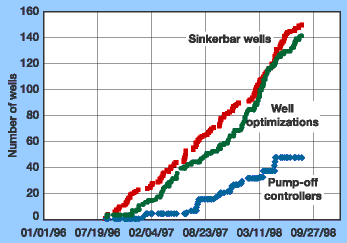
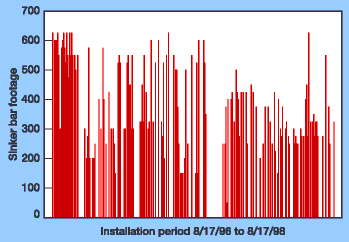
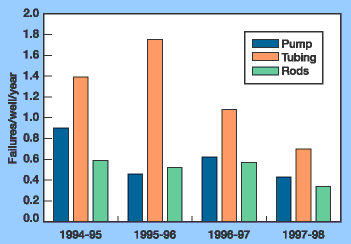
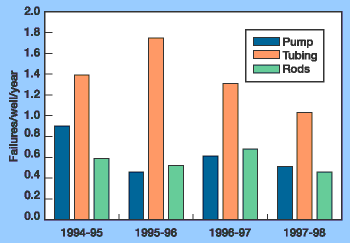
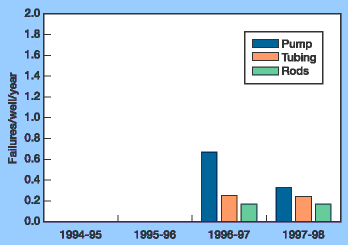
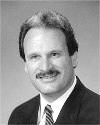 Scott
W. Long is engineering manager for Flexbar, Inc. in
Midland, Texas. He holds a BS degree in mechanical engineering from Oregon State University.
Mr. Long has 25 years of experience as a petroleum engineer with Texaco and Flexbar, is a
licensed professional engineer and a member of SPE.
Scott
W. Long is engineering manager for Flexbar, Inc. in
Midland, Texas. He holds a BS degree in mechanical engineering from Oregon State University.
Mr. Long has 25 years of experience as a petroleum engineer with Texaco and Flexbar, is a
licensed professional engineer and a member of SPE. 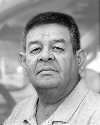 Albert
Garza is lead operations technician and relief
production foreman for Pioneer Natural Resources USA, Inc. in Midland, Texas. He began his
oil field career in 1967 and has worked in various areas of production operations,
specializing in electrical, chemical and rod pumping systems. Twenty-five years of Mr. Garza’s
experience has been near Midland, in the Spraberry Trend area, in lease operations,
automation and total pumping system optimization.
Albert
Garza is lead operations technician and relief
production foreman for Pioneer Natural Resources USA, Inc. in Midland, Texas. He began his
oil field career in 1967 and has worked in various areas of production operations,
specializing in electrical, chemical and rod pumping systems. Twenty-five years of Mr. Garza’s
experience has been near Midland, in the Spraberry Trend area, in lease operations,
automation and total pumping system optimization. Elton
Smith is technician manager of operations for
Pioneer Natural Resources USA, Inc. in Midland, Texas. He has seventeen years of operational
experience with Amerada Hess in a West Texas CO2/WAG injection field, plus a broad range of
experience in artificial lift systems, automation, operational efficiency and project
management. Mr. Smith has been with Pioneer the past three years where he led the
restructuring of production operations practices.
Elton
Smith is technician manager of operations for
Pioneer Natural Resources USA, Inc. in Midland, Texas. He has seventeen years of operational
experience with Amerada Hess in a West Texas CO2/WAG injection field, plus a broad range of
experience in artificial lift systems, automation, operational efficiency and project
management. Mr. Smith has been with Pioneer the past three years where he led the
restructuring of production operations practices. Charlie
Hoff, a senior operations engineer for Pioneer
Natural Resources USA in Las Colinas, Texas, holds a BS degree in petroleum engineering from
Marietta College and an MBA in management from Angelo State University. He has 14 years of
experience as a petroleum engineer with MGF Oil Corp., Parker and Parsley Petroleum Co. and
Pioneer Natural Resources USA, Inc. Mr. Hoff is a member of SPE.
Charlie
Hoff, a senior operations engineer for Pioneer
Natural Resources USA in Las Colinas, Texas, holds a BS degree in petroleum engineering from
Marietta College and an MBA in management from Angelo State University. He has 14 years of
experience as a petroleum engineer with MGF Oil Corp., Parker and Parsley Petroleum Co. and
Pioneer Natural Resources USA, Inc. Mr. Hoff is a member of SPE.
